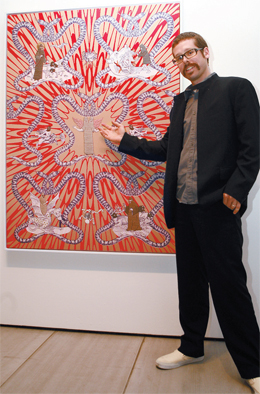Dark secrets on delicate silk screens

Kent Henricksen stands next to his work, “Ethereal Engagements,” at Arario Seoul gallery in central Seoul yesterday. Provided by the gallery
Henricksen’s solo exhibition at Arario Seoul features 15 embroidered silk screen pieces, five sculptures and wallpapers specifically designed for the event. The show began yesterday and continues until June 21.
Henricksen, who lives in New York, interprets and portrays social dilemmas through the use of traditional images, fabrics and printing techniques.
This exhibition, titled “Divine Dualities,” employs these techniques to shroud a series of images fraught with conflict.
The masked and hooded male figures in his work are immediately suggestive of the Ku Klux Klan and other violent groups, but they are surrounded by embroidered images of peaceful East Asian-style landscapes or religious imagery. Angels are replaced by the hooded men, and the masked characters may seem threatening but seen from another angle they could also look cute or comical.
The violence symbolized by the masked characters is re-situated within the context of the feminine and domestic medium of embroidery. The images are also bound by elaborately decorative and brightly gilded frames similar to those used in a museum.
Kent was first inspired by the uniforms worn by the Tamil Tigers of Sri Lanka, a militant group founded in the 1970s that wore hoods and masks with wide openings for the eyes.
Later, Henricksen began experimenting with the details. He used white thread to make two separate eyeholes, adding a mouth that made the character resemble a robber in a ski mask, or a medieval executioner.
He also began altering the shapes and colors of the hoods and the skin tones underneath the open eye holes to show that violence crosses cultural lines.
“Instead of directly revealing the atrocious imagery of terror and fear, he camouflages it among the alluring scenario of a false utopia, and this is where the irony of his work resides,” said Kwon Boo-kyung, the curator of the exhibition.
Arario Seoul can be reached from Anguk Station, line No. 3, exit No. 1. The gallery is open daily from 11 a.m. to 7 p.m. except Mondays. Admission is free. For more information, call (02) 723-6190 or visit www.ararioseoul.com.
By Limb Jae-un [jbiz91@joongang.co.kr]










with the Korea JoongAng Daily
To write comments, please log in to one of the accounts.
Standards Board Policy (0/250자)